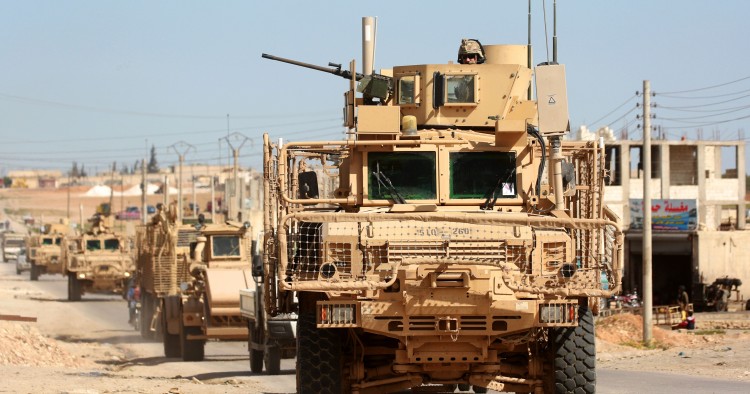President Donald Trump is doing the right thing on Syria — removing U.S. forces — but for the wrong reasons. As a consequence, the value and import of his decision will be less than might otherwise be the case.
Since Trump’s withdrawal declaration, there have been efforts to embellish the internal interagency deliberations of the last six months as a reasoned, well-structured process that aimed at fulfilling the president’s directive to retreat. Trump’s decision before Christmas to withdraw all US forces from Syria (apparently including the air campaign against ISIS east of the Euphrates) was capricious and ill-formed — that is, of a piece with all of his decisions. The choice to leave Syria, if that in fact is what the president has decided, bears only a passing reference to proper policy deliberation and the basic requirements of institutional consensus.
Even without the proper vetting that is vital to the integrity of American policymaking, however, Trump’s instinct that there is nothing left for the U.S. to accomplish in Syria is correct.
In recent months, particularly since the appointment of James Jeffrey as special envoy for Syria, Trump’s foreign policy system has tried to construct a coherent and logical case for a permanent military deployment in Syria that aims at frustrating Damascus’ ability to restore sovereign control over its land and borders and undermining the postwar economic rehabilitation of the country.
Formulaic declarations in support of a continuing campaign against ISIS were supplemented by policy equations that tied the U.S. deployment in Syria to Iran’s presence there — and the suggestion that the resulting “leverage” would somehow compel Iran to disengage. To top things off, Washington declared its interest in frustrating the repatriation of refugees and undermining an international rehabilitation and reconstruction effort as long as Bashar al-Assad remains in power.
This policy is the product of a foreign policy system that has consistently misunderstood Syria, its history, and politics, and is destined to fail. Indeed, in the months before Trump’s announcement every other player on the Syrian stage was racing ahead of Washington in efforts, some of which (like the Astana process) were complementary, while others (like the hardening Turkish-Kurdish standoff) were not, to maximize interests in a post-war Syria ruled by the Ba’ath Party under President al-Assad.
U.S. efforts, centering around maintaining a Kurdish force committed to opposing not only ISIS but also Damascus, could never accommodate the evolving rapprochement between its Kurdish proxies and the regime that began in earnest last spring and will necessarily result in the return of state institutions to the area. Since Trump’s announcement, the pace of this rapprochement has accelerated, destroying any prospect for an open-ended U.S. presence.
Whether the U.S. retreat is accomplished in 30 days or 300 is now beside the point. Critical steps along road to the return of central Syrian authority to the northeast, in league with forces equipped by Washington, have already been taken. Their new mission is not to frustrate Damascus’ return but to enable it, if only to protect Syria (and themselves) against a foreign, Turkish invasion. A more nuanced policy by Washington could improve the terms of this rapprochement, but there is no evidence that Trump, the State Department, Pentagon, or National Security Council are interested in playing this game.
Syrian troops, which never entirely left the region, are returning, most significantly to Manbij. By so doing Syria is reestablishing it sovereign control over the border with Turkey, removing a critical challenge to the Erdogan government that, had it been left to fester under U.S. leadership, would have resulted in a Turkish invasion of Syria in an effort to defeat the Kurds.
Isolating Damascus increasingly looks like yesterday’s policy.
Israel was among the first to grasp the consequences of al-Assad’s military victory. The contested Golan border has been reconstituted and UN forces redeployed, with the significant addition of Russian peacekeepers. Jordan is engaged in a multifaceted reconciliation with Syria across a broad political, institutional, and trade front. Lebanese voices arguing in favor of a restoration of trade and political ties with Damascus are growing louder, and even Turkey is watching approvingly as the dialogue between the Syrian army and the Syrian Democratic Forces rebrands what were formerly U.S. proxy forces. Those soldiers may well become, as they were before the war, Kurdish elements of the Syrian army along Syria’s newly pacific border with Turkey.
Every player in this drama has an explicit and well-defined agenda of interests that it seeks to introduce as the new rules of postwar Syria emerge. Everyone that is, except Washington.
Trump’s stated reasons for withdrawal — the victory over ISIS and bringing the boys home — are to be applauded. But these reasons are divorced from any strategic context. What indeed is the broad vision animating Trump’s Syria policy beyond a visceral isolationism? Far better that Trump’s decisions aim at promoting the restoration of Syrian sovereignty throughout the country, reintegrating Kurdish forces into the Syrian army where they originated, and capitalizing on the Arab rapprochement with Damascus by ending the economic siege of the country and facilitating the return of refugees.
DELIL SOULEIMAN/AFP/Getty Images
The Middle East Institute (MEI) is an independent, non-partisan, non-for-profit, educational organization. It does not engage in advocacy and its scholars’ opinions are their own. MEI welcomes financial donations, but retains sole editorial control over its work and its publications reflect only the authors’ views. For a listing of MEI donors, please click here.













